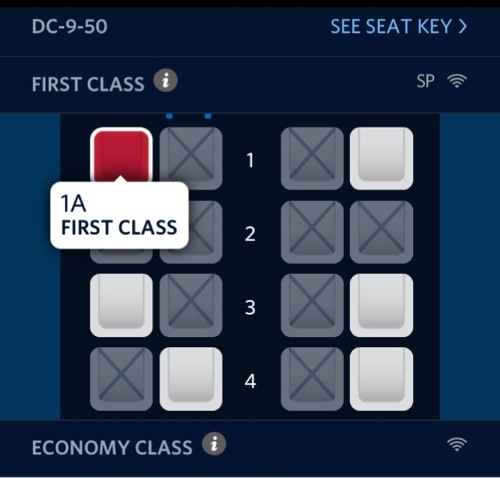A fellow Boarding Area blogger over at Frequently Flying shares vintage seat maps from older / retired airplanes. Its a way to see how seats used to be configured or remember your days flying an older airplane. In his latest one he asked what seat would you choose in the vintage DC9 seat map. My response was – Vintage? I’m flying a DC 9 next week. These DC 9s have an average age of over 30 years but are still flying.
Delta picked up a few DC 9s in the Northwest acquisition and yes, they are still flying them. They even pulled a few back into service that had been placed in parking. These planes are so old, maybe they do deserve to be called vintage.
So when looking at the vintage seat map, I selected seat 1 A. If I recall correctly, the bulkhead seats don’t crunch my knees and they are a long way from the engines in the back.
What seat would you select from this “vintage” seat map? I wonder when Delta will finally retire this relic?
Finish this sentence: The DC 9 plane is so old…__________________
Sign up for Email || Twitter || Facebook || Tips & Tricks
Hotel Offers || Airline Offers || Bank Offers || Cash Back Offers


Of course its ‘vintage’!!!! Its from an airline that no longer exists (outside of some pilot contracts, at least) and a type that no major carrier operates anymore (the -30, not a -50 like Delta). Besides, he posts lots of seat maps for types that are still flying, last month he did an old-config UA 747-400 which will be around for years. What is ‘vintage’ is the seat map and layout itself, not the airframe.
Flew a Delta DC 9 about two weeks ago. It was actually a very nice flight and Northwest had put new interiors a little over a decade ago which still look ok.
Yep, Delta’s DC-9’s are over 30 years old. Their JT8D engines burn a lot of fuel, but they are probably 100% paid for, so no financing costs.
1A is far away from the engines, interior is okay, so I’d say enjoy the trip. The back rows in economy are a different story (like AA MD-80’s = DC-9-80 more or less).
I think they’re getting rid of them when the 717s roll in. Q4?
Hi James – I’ve read early 2014.
Just for you, I’ll have to next post a Delta DC-9-30 seat map from the 1980s… look for it next week. 😉
Hi Darren – We’ll see how it compares to the Delta DC9-50 they currently fly.
The DC 9 plane is so old…my father used to pilot this plane (& he’s long retired!).
The DC-9 is so old that it was the first plane I ever flew on. Eastern, RDU-DCA.
If you’re old enough…
I can remember the day when most seat assignment was accomplished at the check-in desk. In addition to verifying processing and stamping your red-carbon ticket, the desk agent offered a heavy cardboard layout of th e assigned aircraft’s seating plan. You designated you chosen seat by popping off a die-cut square of cardboard that was subsequently stapled to your ticket folio. That folio, with the necessary stamps, red ticket coupons and the seat assignment chit constituted what we no call a Boarding Pass. The ticket and gate agents may have been lucky enough to be working from a primitive Computer Printed manifest, but equally as often it was a carbon copy of a had-written or typed passenger list. Some how it all worked just fine. And in those days, a far greater percentage of flights actually departed on time. And yes, what I’ve carefully omitted is ant comparison with the number of flights flown today, the staggering numbers of passengers accommodated and the dramatic increase in airplane size. In those days, a ‘big’ airplane serving a trans-con flight was powered by four very loud radial engines and the largest of the group typically carried less than 100 passengers. OK, no one said my comparisons had to be fair! Heck, even the ‘stews,’a legitimate term in the day, offered single chew pieces of Double Mint gum to help with pressure changes during climb and decent, reminding each passenger to retain t he wrapper for convenient and sanitary disposal.
“like AA MD-80′s = DC-9-80 more or less…” There’s no ”
more or less” about it. An MD-80’s type cert will say “DC-9-80” that’s how the design evolved. The MD 80 is, in fact, a DC-9